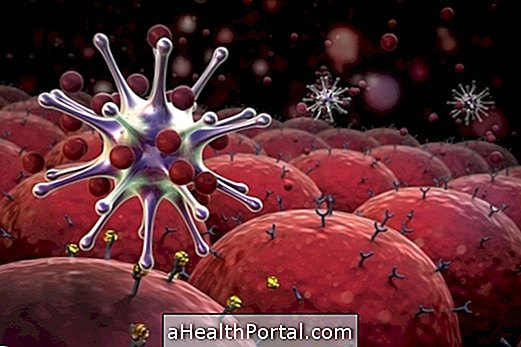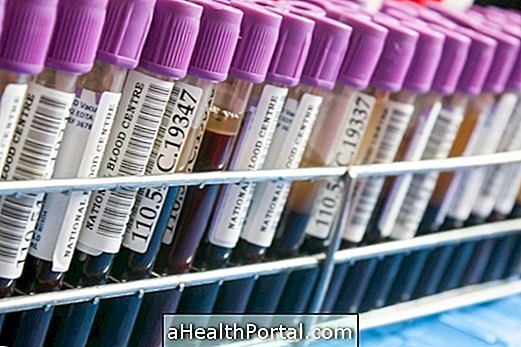Lymphocytes are a type of defense cell of the body, also known as white blood cells, which are produced in greater quantity when there is an infection and is therefore a good indicator of the state of health of the patient.
Normally, the number of lymphocytes can be evaluated through blood tests, and when they are increased it is usually a sign of an infection and therefore it is recommended to consult a general practitioner to diagnose the problem and initiate appropriate treatment.

Altered lymphocytes
The normal reference values of the lymphocytes are between 1000 and 5000 lymphocytes per mm³ of blood, which represents from 20 to 50% in the relative count, and may vary according to the laboratory in which the examination is done. When the values are above or below the reference value, a lymphocytosis or lymphopenia picture, respectively, is characterized.
1. High lymphocytes
The amount of lymphocytes above the reference values is called lymphocytosis and is usually related to infectious processes. Thus, the main causes of high lymphocytes are:
- Acute infections, such as mononucleosis, poliomyelitis, measles, rubella, dengue or pertussis, for example;
- Chronic infections such as tuberculosis, malaria;
- Viral hepatitis;
- Hyperthyroidism;
- Pernicious anemia, which is characterized by deficiency of folic acid and vitamin B12;
- Intoxication by benzene and heavy metals;
- Diabetes;
- Obesity;
- Allergy.
In addition, the increase in the number of lymphocytes can also happen due to physiological situations, such as pregnant women and infants, as well as nutritional deficiencies such as vitamin C, D deficiency or calcium.
2. Low lymphocytes
The amount of lymphocytes below the reference values is called lymphopenia and is usually related to situations involving the bone marrow, such as aplastic anemia or leukemia, for example. In addition, lymphopenia can also be a sign of autoimmune diseases, in which the body itself acts against the immune defense system, such as systemic lupus erythematosus, for example (SLE).
Lymphopenia can still happen due to AIDS, therapy with immunosuppressive drugs or chemotherapeutic or radiotherapeutic treatment, rare genetic diseases, or be the consequence of stress situations, such as postoperative and body overload, for example.
Types of lymphocytes
There are two main types of lymphocytes in the body, B lymphocytes, which are immature cells produced in the bone marrow and released into the bloodstream to produce antibodies against bacteria, viruses and fungi, and T lymphocytes, which are produced in the bone marrow but which are then developed in the thymus until they are divided into 3 groups:
- CD4 T lymphocytes help B lymphocytes to eliminate infections, being the first alert of the immune system. Usually these are the first cells to be affected by the HIV virus, and in infected patients the blood test indicates a value less than 100 / mm³.
- CD8 T lymphocytes: they decrease the activity of other types of lymphocytes and, therefore, they are increased in cases of HIV;
- Cytotoxic T lymphocytes: Destroy abnormal cells and become infected with viruses or bacteria.
However, lymphocyte type tests, especially of the CD4 or CD8 type, should always be interpreted by a physician to assess whether there is a risk of HIV, for example, since other diseases can also cause the same type of changes.
So if there is doubt about being infected with HIV it is advisable to do the laboratory test that looks for the virus inside the cells of the body. Learn more about HIV testing.
What are atypical lymphocytes?
Atypical lymphocytes are lymphocytes that present a varied form and usually appear when there are infections, mainly viral infections, such as mononucleosis, herpes, AIDS, rubella and chickenpox. In addition to the onset of viral infections, atypical lymphocytes can be identified on the blood count when there is a bacterial infection, such as tuberculosis and syphilis, protozoal infection, such as toxoplasmosis, hypersensitivity to drugs or autoimmune diseases such as lupus.
Usually the amount of these lymphocytes returns to normal (reference value of the atypical lymphocytes is 0%) when the causative agent of the infection is eliminated.
These lymphocytes are considered activated T lymphocytes that are produced in response to infected type B lymphocytes and perform the same functions as typical lymphocytes in the immune response. Atypical lymphocytes are generally larger than normal lymphocytes and vary in shape.























